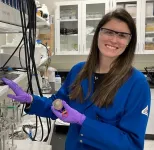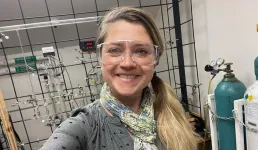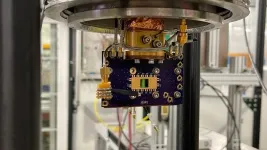(Press-News.org) Micro- and nanoscale plastic particles in soil and water can significantly increase how much toxic chemicals plants and human intestinal cells absorb, according to two new studies from Rutgers Health that raise fresh concerns about food safety from plastic pollution.
The first study in NanoImpact found that lettuce exposed to both nanoscale plastic particles and common environmental pollutants such as arsenic took up substantially more of the toxic substances than plants exposed to the pollutants, alone confirming the risks of polycontamination of our food chain. A companion study in Microplastics journal showed similar effects in human intestinal tissue.
The combination of both studies suggests micro and nano plastics, the byproduct of fragmentation of plastics in the environment over time, could be creating a dangerous cycle of contamination: making plants absorb more toxic chemicals that we might then eat, while making our bodies more likely to also absorb both those toxins and the plastics themselves and increasing risks for diseases, especially for susceptible populations.
"We’ve already put about 7 billion metric tons of plastics into the environment that keep breaking apart," said Philip Demokritou, director of the Nanoscience and Advanced Materials Center at Environmental Occupational HealthSciences Institute at Rutgers University and senior author of both studies. "They pollute everything around us – the water we drink, the food we eat, the air we breathe."
Using a cellular model of the human small intestine, coupled with a lab-based gastrointestinal apparatus that simulates the digestive system, the researchers found that nano-size plastic particles increased the absorption of arsenic by nearly six-fold compared with arsenic exposure alone. The same effect was seen with boscalid, a commonly used pesticide, said the researchers from Rutgers, the Connecticut Agriculture Experiment Station (CAES) and New Jersey Institute of Technology (NJIT).
The relationship, moreover, worked both ways: The presence of these environmental pollutants also significantly increased the amount of plastic absorbed by the intestinal tissue, with plastic uptake roughly doubling when toxins were present.
"We know nanoscale materials can bypass biological barriers," said Demokritou, the Henry Rutgers Chair and professor in nanoscience and environmental bioengineering at the Rutgers School of Public Health and the Rutgers School of Engineering. "The smaller the particles, the more they can bypass biological barriers in our bodies that protect us."
For the other paper, the researchers exposed lettuce plants to two sizes of polystyrene particles – 20 nanometers and 1,000 nanometers – along with arsenic and boscalid. They found the smaller particles had the biggest impact, increasing arsenic uptake into edible plant tissues nearly threefold compared to plants exposed to arsenic alone.
The effects occurred in both hydroponic systems and more realistic soil conditions. Using advanced imaging and analytical techniques, the researchers showed the plastic particles themselves were also accumulating in plant tissues, with the smaller particles more likely to move from roots into shoots.
Micro and nanoplastics come from the slow breakdown of larger pieces of plastic in the environment.
"Even if we stop today producing plastics or using plastics, we have plenty of plastic waste unfortunately out there," Demokritou said.
The research was part of a larger USDA-funded project examining food safety issues related to micro and nanoplastics. The scientists said more research is needed to understand the long-term implications and to develop potential solutions.
"We need to stick with the ‘three-R’ waste hierarchy – reduce the use of plastics, reuse, recycle," Demokritou said. "For areas where you cannot apply these three Rs, like in agriculture where so much plastic is used for weed control and other things, use biodegradable plastics."
The researchers are developing new biodegradable materials that could replace conventional plastics and methods to better detect and measure plastic particles in food and water. However, they said preventing further contamination needs to be a priority.
"It's not that technically we cannot address some of these issues," Demokritou said. "But it will definitely be a challenge to retain all the benefits from this very useful material while reducing the harms that it does. There are social and economic obstacles related to plastic production and use to overcome.”
END
Micro-nano plastics make other pollutants more dangerous to plants and intestinal cells
2025-02-11
ELSE PRESS RELEASES FROM THIS DATE:
Study of female genital tract reveals key findings
2025-02-11
Seeking to understand what constitutes a healthy vaginal microbiome, a global research collaboration that includes a Rutgers-New Brunswick scientist has reported a series of findings, including identifying which bacteria thwart vaginal disease and determining that microbiomes vary significantly across human populations.
Authors of the study, published in Trends in Microbiology, are part of a Belgium-based initiative called the Isala Sisterhood. Members of the group aim to inspire research on microbiomes worldwide by creating a “reference map” of vaginal microbiota. Launched in 2020 at the University of Antwerp, the project has expanded to include more than 3,000 ...
Pitt Engineering Professor Fang Peng elected to National Academy of Engineering
2025-02-11
The National Academy of Engineering (NAE) today announced that University of Pittsburgh Professor Fang Peng, an internationally acclaimed power electronics researcher, is among the newest cohort elected to the academy. The NAE is recognizing Peng for “contributions to the development of high-powered electronic technologies for advanced power grid and energy conversion.”
Peng, the RK Mellon Endowed Chair Professor of Electrical and Computer Engineering and Director of the Energy GRID Institute at Pitt’s Swanson School of Engineering, ...
Short-course radiation therapy effective for endometrial cancer patients
2025-02-11
In a randomized clinical trial, researchers from Huntsman Cancer Institute at the University of Utah (the U) have found that short-course, higher dose vaginal brachytherapy for endometrial cancer had similar effectiveness to more frequent, lower dose sessions.
Gita Suneja, MD, MS, physician-scientist at Huntsman Cancer Institute and professor of radiation oncology at the U, is the first author of the SAVE trial report—which stands for, Short-Course Adjuvant Vaginal Cuff Brachytherapy in Early Endometrial Cancer Compared with Standard of Care.
“There ...
Breast cancer treatment advances with light-activated ‘smart bomb’
2025-02-11
Scientists have developed new light-sensitive chemicals that can radically improve the treatment of aggressive cancers with minimal side effects. In mouse tests, the new therapy completely eradicated metastatic breast cancer tumors.
The novel chemicals, called cyanine-carborane salts, and their role in the next-generation of cancer treatments, are described in a new article published in Angewandte Chemie, a journal of the German Chemical Society.
Photodynamic therapy, or PDT, has been used for decades to treat forms of skin and bladder cancers. It works by flooding a patient’s body with light-sensitive chemicals that accumulate in cancer cells. ...
JSCAI article at THT 2025 sets the standard for training pathways in interventional heart failure
2025-02-11
WASHINGTON–Interventional heart failure (IHF) has rapidly evolved as a critical subspecialty within cardiology at the crossroads of advanced heart failure and interventional cardiology. The increasing complexity of patient care—spanning both pharmacological treatments and an expanding array of device-based therapies—has underscored the urgent need for a standardized approach to training and career development in this field.
That’s the message from experts in a comprehensive review, “Charting the Course for Careers in Interventional Heart ...
Engineering biological reaction crucibles to rapidly produce proteins
2025-02-11
Biomedical engineers at Duke University have demonstrated a new synthetic approach that turbocharges bacteria into producing more of a specific protein, even proteins that would normally destroy them, such as antibiotics.
The technique directs bacteria to produce synthetic disordered proteins that bunch together to form compartments called biological condensates. When these compartments trap mRNA carrying instructions for specific proteins together with the machinery needed to implement them, they can greatly enhance the rate of protein production.
The technique could be a boon to industries that use bacteria to produce a wide range of products such as pharmaceuticals, ...
Minecraft: a gamechanger for children’s learning
2025-02-11
It’s the globally popular video game that’s captured the attention of more than 141 million active players, but Minecraft can also play a significant role in shaping children’s development, social interactions, and cognitive learning, say researchers at the University of South Australia.
Published in the new book Children’s online learning and interaction, the study found that when children engage in collaborative Minecraft play, they foster teamwork, communication, and social skills as players exchange ideas and problem-solve ...
Presidential awards spotlight naval research excellence
2025-02-11
WASHINGTON, D.C. – An alternative energy mechanical engineer, two aerospace engineers, and a corrosion research engineer received the highest honor bestowed to early career U.S. government scientists and engineers.
These four U.S. Naval Research Laboratory (NRL) researchers each received a Presidential Early Career Award for Scientists and Engineers (PECASE) for their research on next generation energy storage solutions, solid fuel combustion for use in high-speed propulsion devices, solving large-scale ...
SETI Institute names first Frank Drake Postdoctoral Fellow
2025-02-11
February 11, 2025, Mountain View, CA -- The SETI Institute awarded the first Frank Drake Postdoctoral Fellowship to Dr. Anastasia Yanchilina. Yanchilina will focus on distinguishing biosignatures from false positives across space and time. Her research combines experimental and analytical research to refine biosignature detection techniques. She will conduct lab experiments to generate key mineral analogs and study Earth’s extreme environments to understand what potential signs of life to look for on other planets.
“It has long been my scientific dream to explore whether life exists ...
From photons to protons: Argonne team makes breakthrough in high-energy particle detection
2025-02-11
Particle detectors play a crucial role in our understanding of the fundamental building blocks of the universe. They allow scientists to study the behavior and properties of the particles produced in high-energy collisions. Such particles are boosted to near the speed of light in large accelerators and then smashed into targets or other particles where they are then analyzed with detectors. Traditional detectors, however, lack the needed sensitivity and precision for certain types of research.
Researchers at the U.S. Department of ...







